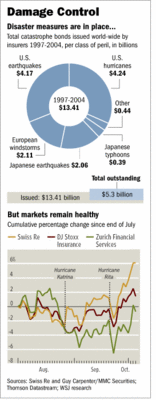銀監會副主席唐雙寧表示,次級債存在局限,因此建議,商業銀行可考慮發行高等級的次級金融債券以補充資本,亦可以考慮利用混合型資本工具提高資本充足比率,並且可以考慮換股債及通過資產證券化分散和轉移信用風險。
他指出,次級債是商業銀行補充資本及提高資本充足比率的重要方式,但存在局限,包括不能成為核心資本、發行成本高及未必能全部計入資本中等。
唐雙寧說,次級債不能構成核心資本,在計算資本充足比率時只能計入附屬資本。因此,除非銀行破產或清算,次級債不能用於彌補銀行日常的經營損失,不能用於抵銷銀行壞賬,因此不要以為發次級債可大大增強銀行抵禦風險的能力。
此外他稱,次級債務不得超過核心資本淨額的50%,證明利用發債提高資本充足比率是有條件限制的。目前有商業銀行雖然發行了次級債,但由於核心資本不足,次級債無法或者無法全部計入資本當中。另外,發行次級債成本較高,同時次級債有「打折」的期限。按照《商業銀行資本充足比率管理辦法》的規定,可以計入附屬資本的次級債務在距到期日前最後5年,每年「打折」20%。
最後,商業銀行相互持有次級債會帶來系統性風險。各行之間相互持有次級債雖然提高單家銀行資本充足比率水平,但沒有從根本上改善銀行體系總體抵禦風險能力。在經濟金融運行出現波動時,倘若一家銀行出現償付危機,可能連鎖性地帶動其他銀行出現危機,進而引發系統性金融風險。
星期日, 10月 23, 2005
星期六, 10月 15, 2005
內地關於房地產貸款的指引
根據《商業銀行房地產貸款風險管理指引》,除非開發商以權益形式提供有關房地產發展項目總投資額35% 或以上的資金,否則銀行不得向房地產開發商發放貸款。銀行必須留意住房按揭貸款借款人的還款能力,以確保借款人的每月房屋支出及每月債務還本付息總額分別不超過其每月收入的50% 及55% 。此外,根據2005 年1 月1日生效的中國最高人民法院的司法解釋,如果這些抵押品是借款人的必要住所,法院不得查封、拍賣或以其他方式變賣抵押品。
五級分類法
讀建行的招股書的最大得著,就是了解內地銀行業的規例及操作,現把有用的資訊摘錄如下:
目前,中國的銀行應按照五級分類方法根據估計的貸款本息償還的可能性對貸款進行分類。在實行現行的貸款五級分類之前,銀行通常根據還款狀況、借款人是否已破產等因素將貸款分為四類,即正常、逾期、呆滯和呆賬。貸款五級分類制度最初由人民銀行在1999年宣佈試點實施,2002年銀行被要求根據人民銀行的貸款分類原則正式採用該制度。評估還款可能性的主要因素包括借款人現金流量、財務狀況、以及信用記錄。下表列出五級分類及其相應的定義:
分類特點
正常. . . . . . . . . 借款人能夠履行貸款條款;無理由懷疑其全額及時償還本息的能力。
關注. . . . . . . . . 借款人當前能夠償還其貸款,但是還款可能受到特定因素的不利影響。
次級. . . . . . . . . 借款人的還款能力出現問題,不能完全依靠其正常經營收入償還本息。即使執行抵押或擔保,損失仍可能發生。
可疑. . . . . . . . . 借款人不能足額償還本息,即使執行抵押或擔保也肯定要發生較大損失。
損失. . . . . . . . . 即使採取所有可能的措施和用盡所有法律補救方法,仍不能償還本息,或只能償還甚少部分。
根據人民銀行的準備計提指引,中國的銀行須以審慎及時原則根據對損失可能性的合理預測作出準備。根據貸款分類指引,劃分為次級、可疑和損失類的貸款均被視為不良貸款。減值損失準備包括一般準備、專項準備和特種準備。銀行應按季計提減值損失準備,一般準備於任何年度12 月31日的餘額應不低於年末貸款餘額的1%。銀行可參照以下比例計提專項準備:對於次級類貸款,計提比例為25%;對於可疑類貸款,計提比例為50%;對於損失類貸款,計提比例為100%。其中,就次級和可疑類貸款而言,銀行可根據本身對相關貸款的風險評估,酌情調整減值損失專項準備的計提比例,幅度為指引水平以下20% 至指引水平以上20% 。商業銀行可以每季根據特別風險因素(包括與若干行業及國家有關的風險)、一般損失率及過往經驗作出特別準備。
目前,中國的銀行應按照五級分類方法根據估計的貸款本息償還的可能性對貸款進行分類。在實行現行的貸款五級分類之前,銀行通常根據還款狀況、借款人是否已破產等因素將貸款分為四類,即正常、逾期、呆滯和呆賬。貸款五級分類制度最初由人民銀行在1999年宣佈試點實施,2002年銀行被要求根據人民銀行的貸款分類原則正式採用該制度。評估還款可能性的主要因素包括借款人現金流量、財務狀況、以及信用記錄。下表列出五級分類及其相應的定義:
分類特點
正常. . . . . . . . . 借款人能夠履行貸款條款;無理由懷疑其全額及時償還本息的能力。
關注. . . . . . . . . 借款人當前能夠償還其貸款,但是還款可能受到特定因素的不利影響。
次級. . . . . . . . . 借款人的還款能力出現問題,不能完全依靠其正常經營收入償還本息。即使執行抵押或擔保,損失仍可能發生。
可疑. . . . . . . . . 借款人不能足額償還本息,即使執行抵押或擔保也肯定要發生較大損失。
損失. . . . . . . . . 即使採取所有可能的措施和用盡所有法律補救方法,仍不能償還本息,或只能償還甚少部分。
根據人民銀行的準備計提指引,中國的銀行須以審慎及時原則根據對損失可能性的合理預測作出準備。根據貸款分類指引,劃分為次級、可疑和損失類的貸款均被視為不良貸款。減值損失準備包括一般準備、專項準備和特種準備。銀行應按季計提減值損失準備,一般準備於任何年度12 月31日的餘額應不低於年末貸款餘額的1%。銀行可參照以下比例計提專項準備:對於次級類貸款,計提比例為25%;對於可疑類貸款,計提比例為50%;對於損失類貸款,計提比例為100%。其中,就次級和可疑類貸款而言,銀行可根據本身對相關貸款的風險評估,酌情調整減值損失專項準備的計提比例,幅度為指引水平以下20% 至指引水平以上20% 。商業銀行可以每季根據特別風險因素(包括與若干行業及國家有關的風險)、一般損失率及過往經驗作出特別準備。
星期四, 10月 06, 2005
星期日, 10月 02, 2005
Patching the basket

Sep 29th 2005 HONG KONG
The Economist
China takes another tiny step towards a flexible currency
SO NEW, and already there's a hole. Two months after abandoning the yuan's peg to the dollar for a link to a basket of several currencies, China has been forced to weave part of the basket again. On September 23rd, the People's Bank of China said that the yuan would be allowed to fluctuate by 3% a day against the euro, yen and other non-dollar currencies, compared with 1.5% previously. Daily movements against the dollar, meanwhile, remain limited to only 0.3%.
The reason for the change seems wholly practical. Under its old exchange-rate system, China controlled the yuan's value against the dollar, but allowed a fair bit of movement against other currencies. When it moved to a basket on July 21st—revaluing the yuan by 2.1% in the process—the corollary was tighter limits on daily fluctuations against currencies other than the dollar. But maintaining these has proved cumbersome.
Suppose that the euro jumps by 2% against the dollar in a day—a big move, but not unheard of. The European currency should then rise against the yuan as well. But it would not be possible to accommodate the full change within the 1.5% and 0.3% trading bands—unless the Chinese central bank could somehow nudge the dollar back up against the euro. Indeed, there have been rumours that over the past few weeks the monetary authorities have been using their copious foreign-exchange reserves to intervene in precisely this fashion.
Allowing non-dollar currencies to fluctuate by 3% gives the Chinese authorities a little more leeway, lessening the need for expensive intervention. It should also cut potential trading losses at designated foreign-exchange banks, because they can now hedge more effectively. It will also reduce currency speculation, if the wider bands are harder to put under pressure.
The timing of the change was also expeditious. Coming just before the meetings of the IMF, the World Bank and the G8 in Washington, DC, it allowed China to deflect charges that it is still frustrating a meaningful appreciation of the yuan. Since the peg was abandoned, the Chinese currency has risen by a mere 0.2% against the dollar (see chart).
True to form, the day the Washington meetings closed, on September 25th, the central bank made a further declaration: that it had no intention of changing the yuan's trading range against the dollar, in which 80% of China's foreign trade is settled. The tweaking of the currency basket so soon after its creation shows that market forces are having some impact on the yuan. Even so, it will be a long time before China has a truly flexible currency.
訂閱:
文章 (Atom)

